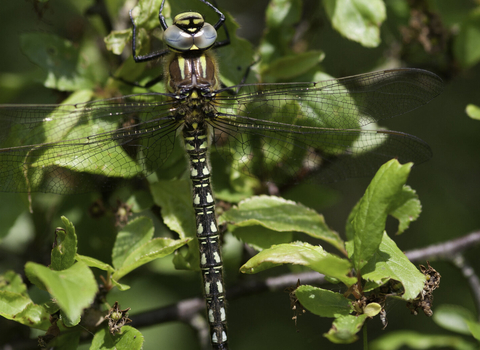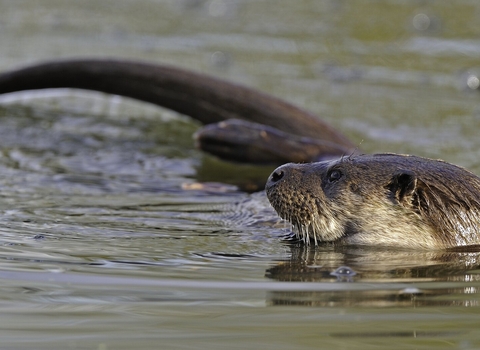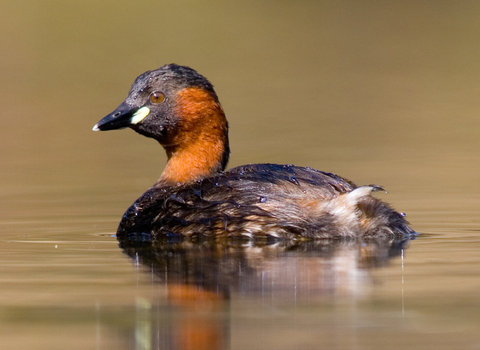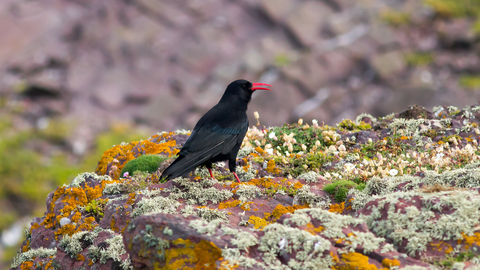
Mike Snelle
Skokholm Island
Know before you go
Dogs
When to visit
Opening times
April-SeptemberBest time to visit
Full seasonAbout the reserve
The plateau of this island slopes gently from 50 metres to around 20 metres above the cliff tops in the east. It is composed mostly of Old Red Sandstone. The farm buildings forming the current accommodation were probably built early in the 18th century. By the beginning of the 20th century, the island had lain derelict for some time. Ronald Lockley then took a lease in 1927, repaired the buildings and gradually built up the Bird Observatory, which operated until 1976 apart from periods during the war years. In 1916 the lighthouse was built, which is now automatic.
The island is famed for its Manx Shearwaters and Storm Petrels and also supports strong colonies of Puffin, as well as Razorbills and Guillemots. There is a large colony of Lesser Black-backed Gulls and Herring Gulls and Great Black-backed Gulls are also present. The island is a breeding site for Oystercatchers and Chough as well as Skylark and Wheatear, and is well known for its migrant birds including Chiffchaff, Willow Warblers, Whitethroat, Spotted and Pied Flycatchers and Redstart. Rare birds have included Spoonbill, Hoopoe, Wryneck, Bluethroat, Glossy Ibis, Purple Heron, Golden Oriole and Lapland Bunting.
Environmental designation
Wildlife to look out for
Birds
The wildlife year starts in March when Manx Shearwaters begin their return to Skokholm. Nearly 50,000 pairs breed in burrows all over the island. They are remarkable seabirds that spend the Welsh winter on the food rich waters off the coast of South America completing an epic 14,000 mile round journey to Skokholm each year. Their streamlined build has evolved to make them masters of their niche in the marine environment, a design that renders them clumsy and vulnerable on land, so to reduce the risk of predation they only return to the island at night.
Shearwaters are not alone in their nocturnal activities. Storm Petrels, petite pelagic seabirds, also wait for the safety of darkness before coming to land. An estimated 2,500 pairs of Storm Petrels breed on Skokholm; it is one of the most accessible colonies in the country. Dark nights in the summer months are therefore filled with the eerie and enchanting calls of these two species.
On the cliff ledges there are thousands of Guillemots and Razorbills and the bays are full of Puffins. Crab Bay in particular is a Puffin paradise where you can sit quietly amongst the birds. The Guillemots and Razorbills are in residence from April to the middle of July. Also nesting on tiny ledges are noisy Fulmars and around the island are colonies of Herring and Lesser Black-backed Gulls while the large Great Black-backed Gulls observe life from rocky outcrops.
Skokholm is run as a bird observatory where daily records of its many resident and migratory birds are kept. Especially in May, August and September the migrants make every day different. You never know what is going to turn up and over the years the island has hosted many special rarities as well as being a hot spot for visible migration, typically the commoner European breeding warblers, flycatchers, pipits and thrushes but also scarcer visitors such as a Wryneck, Hoopoe, Melodious Warbler or Red-breasted Flycatcher.
Historically Skokholm has hosted some exceptional rarities including Scops Owl, Rose-breasted Grosbeak, Baltimore Oriole, Bobolink, Swainson’s Thrush and White-throated Robin.
Plants
The island is awash with salt-loving maritime flora especially in May and June. Swathes of pink Thrift, and white Sea Campion, carpet the green plateau of the island. The maritime grassland and the plant communities within it are specialists of the harsh coastal environment and a real visual treat on a sunny spring morning. The numerous rabbits have a profound and beneficial impact on the vegetation.
The invertebrate fauna is just as exciting, containing many nationally rare species such as Black Banded and Devonshire Wainscot moths. The lichens found on the cliffs and outcrops are of great interest and include several threatened species.
The flora is typical of sub-maritime grassland, grading into heath in places although heavily affected by the resident Rabbit population. The site supports a number of plant species of limited distribution like Three-lobed Water Crowfoot, Tree Mallow and Rock Sea Spurrey as well as Small Nettle, more commonly found in the east. Thrift and Sea Campion occur on the south and west coasts.
The wetland areas support Mudweed, Broad-leaved Pondweed, Marsh St. John’s Wort and Shoreweed, with Lesser Skullcap and Allseed nearby. Saltmarsh species include Sea Milkwort and Common Sea Purslane. An assemblage of nationally scarce and rare lichens occur including the scheduled Golden Hair lichen Teloschistes flavicans.
Mammals
There are no indigenous mammals, but a large and unusually varied population of Rabbits was introduced by the Normans. House Mice were accidentally introduced in the late 19th century and the only reptile on the island is the Slow Worm. Grey Seals breed and haul out on the foreshore and other marine mammals to be seen include Porpoise and Common Dolphin.
History
From 1324 for over 200 years Skokholm was a rabbit farm like many islands. Earlier there had been prehistoric occupation of the island but there has been little archaeological exploration. The first evidence of a house was on a map dated 1693 and Lewis Morris’ map of 1748 also shows a house on the island. The present cottage, the associated buildings, the field walls and possibly the lime kiln were built around 1760. The lighthouse on the west side of the Island was one of the last of its type and was built in 1905. Building materials were moved from the jetty to the lighthouse by a narrow gauge railway, initially powered by a donkey. The tracks can still be seen today.
The island became the property of the Phillips family of Sandy Haven and Haythog in 1713. Through inheritance and marriage it became part of the Dale Castle estate in 1740. It is not known who built the cottage and other buildings, but there is a note suggesting the build cost of the cottage was £150. There were a number of farming tenants up to 1916. The last people to live and farm on Skokholm were Captain Henry Edward Harrison, his wife, 3 daughters, 1 son and 2 servant girls who lived there in the 1860s.
In 1927 the young naturalist Ronald Lockley took on the lease. The house was badly damaged and the other buildings were in ruins. He tried farming chinchilla rabbits and kept sheep, goats and cows, but he is mainly credited with pioneering studies of puffins and Manx shearwaters. He wrote many books about island life and some of the first seabird monographs. He also helped set up the West Wales Field Society, the forerunner of today’s Wildlife Trust, and established the first British Bird Observatory on the island in 1933.
Lockley was forced to leave Skokholm in 1940 when the war started, but the Bird Observatory was re-established in 1946 and continued until 1976, managed by the Dale Fort Field Centre and a number of island wardens. Subsequently The Wildlife Trust took over and continues to run the island today. Records of bird sightings and breeding have continued throughout this time. The Wildlife Trust purchased the island in 2006, but by 2010 the buildings were in a poor state. Plans were then made to re-establish the Bird Observatory and a refurbishment programme, started in 2011, organised and carried out by volunteers from The Friends of Skokholm and Skomer.
By 2015 the Bird Observatory accreditation had been reinstated, and the buildings restored and substantially improved to provide comfortable accommodation for up to 20 guests. In 2012, The Trust purchased the lighthouse from the Admiralty. In 2013 two full-time wardens were employed and accommodated in the lighthouse, which also provides research accommodation.
Ronald and Doris Lockley circa 1929/1930
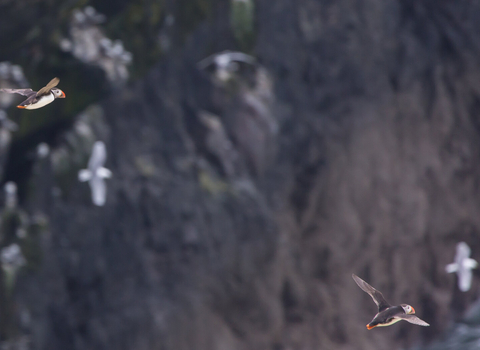
Charles Thody Photography

